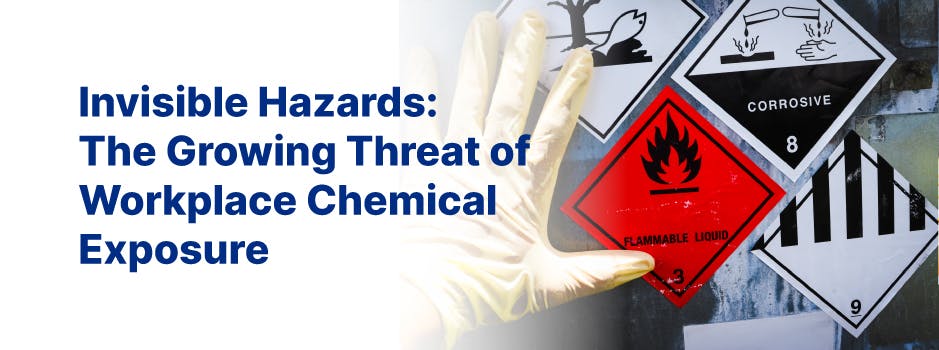The modern workplace is rife with potential hazards, many of which are well-known and visible. However, there is a growing threat that often goes unnoticed – chemical exposure. Chemical hazards are present in a wide range of industries, from manufacturing and agriculture to healthcare and construction. As our world becomes increasingly reliant on chemicals, it is crucial to recognize the risks and protect workers from harm. This article will explore the growing threat of workplace chemical exposure, its impact on worker health, and the steps that can be taken to minimize these risks.
The Prevalence of Chemical Hazards in the Workplace
Chemicals are ubiquitous in today's workplaces, with more than 100,000 unique substances used globally in various industries. The U.S. Occupational Safety and Health Administration (OSHA) estimates that 32 million workers in the United States alone are exposed to hazardous chemicals on the job. This exposure can occur through inhalation, skin contact, or ingestion, and may lead to both acute and chronic health effects.
Despite the widespread presence of these chemicals, their hazards are often underestimated, leading to insufficient safety measures and worker education. As a result, chemical exposure has emerged as one of the most significant threats to workplace safety and health.
The Impact of Chemical Exposure on Worker Health
The consequences of workplace chemical exposure can be severe and wide-ranging. Depending on the type of chemical and the level of exposure, workers may experience immediate or long-term health effects.
- Acute Health Effects
Acute health effects are immediate reactions to chemical exposure, which can range from mild to severe. Symptoms may include irritation of the eyes, skin, and respiratory system, dizziness, headaches, and nausea. In more extreme cases, exposure to hazardous chemicals can result in chemical burns, poisoning, or even death.
- Chronic Health Effects
Chronic health effects are long-term conditions that can develop after prolonged or repeated exposure to hazardous chemicals. These conditions may include respiratory diseases (such as asthma or chronic obstructive pulmonary disease), neurological disorders (like Parkinson's disease or multiple sclerosis), and various types of cancer. Workers exposed to certain chemicals may also be at risk of reproductive issues, such as infertility or birth defects.
- Psychological Effects
The psychological impact of workplace chemical exposure is often overlooked, but it can be significant. Workers who are regularly exposed to hazardous chemicals may experience heightened stress, anxiety, and depression. Moreover, the fear of developing chronic health issues can have a lasting effect on workers' mental well-being.
Addressing the Threat of Workplace Chemical Exposure
To protect workers from the hazards of chemical exposure, it is essential to adopt a multi-faceted approach that includes effective regulations, comprehensive safety programs, and ongoing education.
- Regulations and Enforcement
Establishing stringent regulations and guidelines is a critical first step in addressing workplace chemical exposure. OSHA has developed the Hazard Communication Standard (HCS), which requires employers to provide workers with information about hazardous chemicals in the workplace. In addition, the Globally Harmonized System of Classification and Labelling of Chemicals (GHS) aims to standardize chemical classification and hazard communication worldwide.
However, simply having regulations in place is not enough; enforcement is vital to ensuring compliance. Regulatory agencies must be vigilant in inspecting workplaces and imposing penalties for non-compliance.
- Safety Programs and Controls
Employers should implement comprehensive safety programs that focus on hazard identification, risk assessment, and control measures. These programs should include the following components:
- Regular workplace inspections to identify chemical hazards
- Risk assessments to determine the severity and likelihood of exposure
- Control measures to minimize or eliminate exposure, such as engineering controls (e.g., proper ventilation), administrative controls (e.g., job rotation), and personal protective equipment (PPE
- Training and education programs to teach workers about chemical hazards, proper handling procedures, and the use of PPE
- Emergency response plans to address chemical spills, exposures, or other incidents
- Medical surveillance programs to monitor workers' health and detect early signs of chemical-related illnesses
- Ongoing Education and Awareness
Continuous education and awareness campaigns are crucial in addressing workplace chemical exposure. Employers should provide workers with up-to-date information on the chemicals they handle, their potential hazards, and the best practices for minimizing exposure. Workers must also be encouraged to report any concerns or incidents related to chemical exposure, without fear of retaliation.
- Research and Innovation
Investing in research and innovation can help identify new methods for reducing workplace chemical exposure. This may involve the development of safer alternatives to hazardous chemicals, improved PPE, or innovative engineering controls. Additionally, research should focus on understanding the long-term health effects of chemical exposure to inform better regulatory decisions and safety measures.
- Collaboration and Advocacy
Addressing the growing threat of workplace chemical exposure requires collaboration among various stakeholders, including employers, workers, unions, regulatory agencies, and non-governmental organizations. By working together, these groups can advocate for stronger regulations, share best practices, and raise awareness about the importance of protecting workers from hazardous chemicals.
Conclusion
Workplace chemical exposure is a significant and growing threat that can have serious consequences for worker health. To combat this invisible hazard, it is vital to recognize the risks and take a comprehensive approach to minimize them. By implementing effective regulations, safety programs, ongoing education, research, and collaboration among stakeholders, we can protect workers from the harmful effects of chemical exposure and create a safer, healthier work environment for all.

